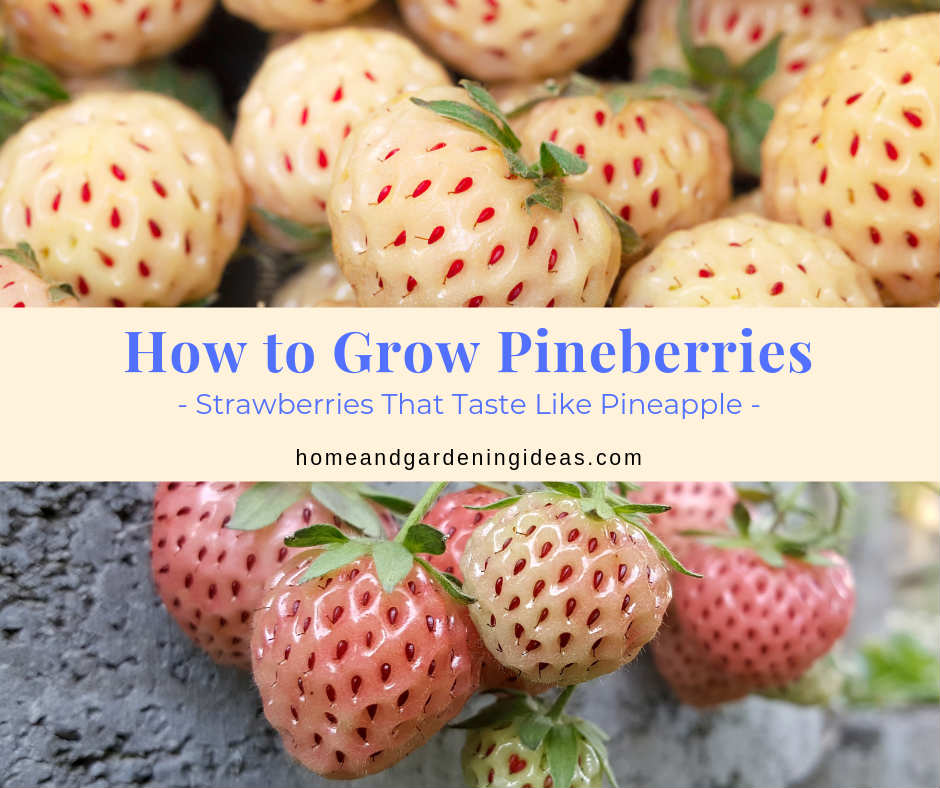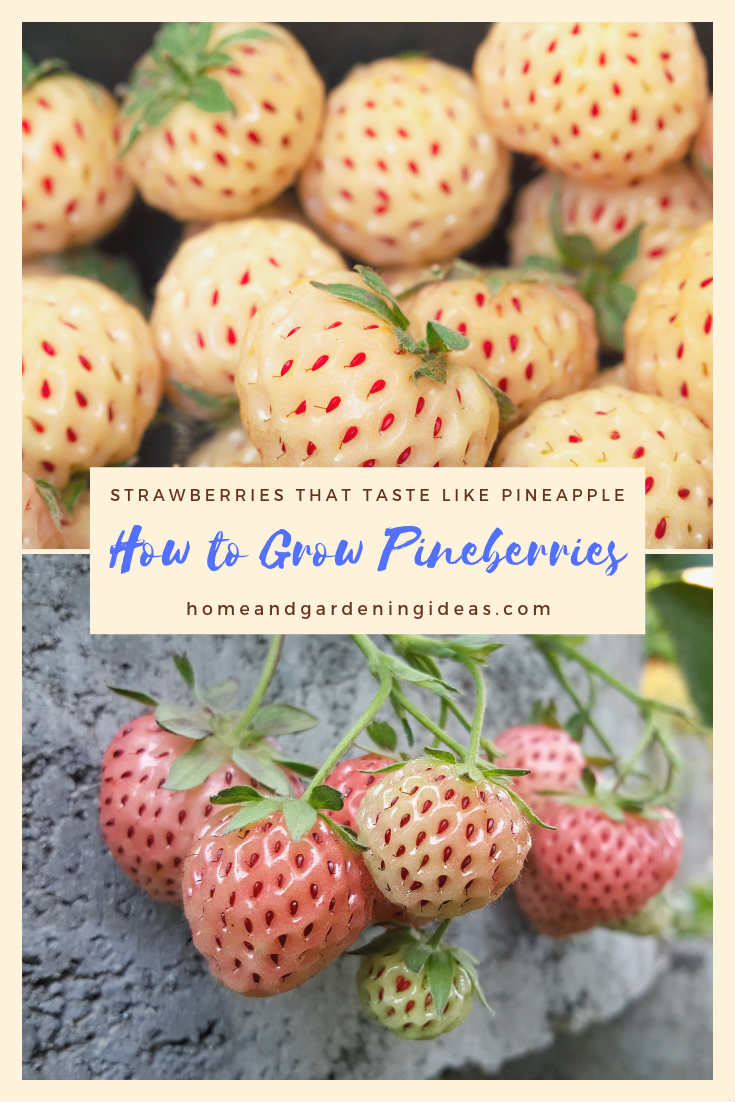How to Grow Pineberries: Strawberries That Taste Like Pineapple

Growing pineapples might pose a challenge for most gardeners who don’t live in a subtropical region, so learning how to grow pineberries is a fantastic substitute. Pineberries are strawberries that taste like pineapples, but they’re not – sneaky.
Pineberries aren’t a cross between a pineapple and a strawberry, but it’s also not genetically modified. Instead, a pineberry is known as a nomenclature. So, it’s a traditionally created cross between two different types of strawberries that won’t reproduce true from seed except on a rare occasion.
Pineberries are unique because they grow just like strawberries, but they produce small white berries instead of red. They have a delicious slight citrusy flavor with red seeds.
Getting Pineberry Plants
It’s best if you use bare-root plants or plants created from runners. You might see if any of your friends have pineberries that can give you runners that create baby plants.
Don’t buy pineberry seeds for sale because they can’t grow true from seeds. You’ll end up with an ordinary red strawberry plant.
When you receive your pineberry roots in the mail, they might seem small and fragile, but it won’t stay that way. Pineberries grow well in USDA zones 4-8, but you might have success in other zones if you grow them in containers and protect them from extreme temperatures.
How to Grow Pineberries
You can grow pineberries well in both open grounds as well as containers (buy containers HERE). Either way, it typically takes a year for the plants to establish and produce abundant harvests. After they produce for the first three years, you’ll want to replace the plants with new ones. Planning means you always have a continuous harvest of pineberries.
Preparing the Soil
Pineberries need fertile soil that’s been supplemented with garden compost or composted manure. Try to mix the compost or manure into the ground as best that you can.
Next, make sure you check the pH level of the soil. Pineberries are woodland plants, so they do prefer slightly acidic soil with an ideal pH range of 5.5 to 6.5. If your soil isn’t at these levels, you’ll need to make proper amendments to change the pH level.
The Best Location for Pineberries
Whether you use containers or a garden bed, pineberries need at least six hours of direct sunlight or 8-10 hours of indirect light. Morning sun is the most ideal, and your yield might be higher if you pick an area that receives 8 hours or more of sunlight. If they do receive a lot of light, pineberries take on a pinkish tint, but it won’t alter the flavor.
When to Plant Pineberries
Are you wondering when the best time is to plant pineberries?
The best time to start pineberries is in the spring after the ground has warmed up a bit, but you do need to protect new strawberries from late spring frosts. If you plant early in the spring, they should start to produce berries the next year, but it might take an extra year to reach maturity.
You can try fall planting if you can provide sufficient winter protection. Many gardeners prefer fall panting because the plants have time to establish a proper root system before the top growth starts. You will need to use a lot of mulch to keep the root zone warm.

Planting Pineberries in Garden Beds
You’ll need to amend the soil for pineberries before planting. Make sure you aren’t using a location that once housed nightshade family plants, such as potatoes, peppers, or tomatoes. Those plants contain fungal spores that can lay dormant for years and destroy pineberry plants.
Preparing the soil is particularly important because they’re perennials, so they’ll be here forever. Try adding some ammonium nitrate and slow-release organic fertilizer to prepare the beds. If the drainage needs to be amended, add some organic matter and sand; you don’t want any standing water.
Pineberries need to have space to spread, but they don’t make as many runners as garden strawberries. You can plant them a bit closer together than regular strawberries, one plant for every 12 inches works well.
Dig small holes and place the pineberry roots in the holes, making sure that their crowns are at soil level, not below. Press down the soil around them and water well.
Planting Pineberries in Containers
Pineberries can be grown in any container (buy containers HERE) that can hold at least a quart of soil. They don’t have extensive root systems, so a 10″-12″ pot that is 8″ deep is sufficient. Drainage is the most crucial factor when picking a container. Some people use hanging baskets or rain gutters, so long as it has proper drainage.
Taking Care of Pineberries
After planted, pineberries need plenty of water to establish well in the containers or garden bed. Keep them well-watered until fall, and then it’s time to slow down on watering to help toughen up the plants for overwintering.
Once you notice berries starting to form on the plants, you can mulch the beds with straw. The straw helps to retain moisture and keep those frustrating weeds at bay. It’s also a great idea to cover the plants with a net once the berries form because birds and other little animals will use your pineberry bed as a buffet. It also helps start the berries from touching the ground and rotting.
Aside from watering and mulching, you also want to feed your pineberry plants a few times a year. Give them a liquid feed of high phosphorous and high potassium fertilizer every 3-4 weeks from mid-spring to promote flowering and fruit set.
Final Thoughts
Pineberries are a unique variety to put in your garden, sparking interest in visitors and selling for top dollar at local farmer’s markets. People love unusual fruits, and learning how to grow pineberries isn’t any harder than growing garden strawberries.
Not only are pineberries delicious eaten fresh from the garden, but they also are lovely in fruit salads and other fun recipes. They’re worth growing in your garden beds or adding a few pots on your patio.
 Home and Gardening Ideas At home and Gardening ideas we believe inspiring readers about homesteading, self sufficiency
Home and Gardening Ideas At home and Gardening ideas we believe inspiring readers about homesteading, self sufficiency





